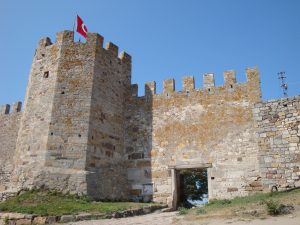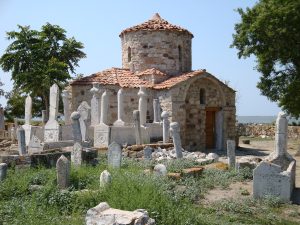Gem of the Gulf of Saros Population: 4,300
Old name: Ainos

With 40 km of golden sand, Enez at the far western end of Trakya (Thrace) ought to be at least as well known as Patara. That it isn’t is in part due to the fact that until 2004 it was off-limits to foreigners because of its proximity to the Greek border. But it’s also partly because there are really two Enezes, the interesting old town and the ugly sprawl of beach resort tacked onto it later.
Backstory
This being Turkey, Ainos passed through the hands of a staggering array of different occupiers before it became Enez. Settlement in the area appears to have started around 4,000 BC when the vestigial town sat right on the Saros Körfezi (Gulf of Saros) at the point where the Meriç river emptied into the sea.
Later, Aeolian settlers from the Greek islands moved in to found trading colonies here, only to be pushed out in the 6th century BC by Persian invaders. The locals fought back by joining the Delian League of Greek city states, which didn’t stop them from falling under first Ptolemaic and then Roman sway.
In Byzantine times, Ainos operated as a virtually independent princedom. Then in the Late Middle Ages the Genoese moved in to add it to their trading empire.
Finally, in 1456 Sultan Mehmet the Conqueror’s general, Has Yunus Bey, rode into town and claimed it for the Ottomans. By then the delta of the Meriç had silted up, leaving the town stranded four km inland, an economic disaster from which it never really recovered.
 Around Old Enez
Around Old Enez
Old Enez is the sleepy small settlement that stands on the site of ancient Ainos.
Arriving there feels a little like arriving at the end of the world, although in no more time that it requires to take a turn round the castle you’ll realise that this was not always the case. For in its prime Ainos must have been an impressive place, endowed with some extraordinary monuments that are still coming to light as excavations about town continue.
Enez castle is by far the most significant monument. Inside it stands a wonderful building that deserves to be far better known, a vast Byzantine basilica dedicated to Haghia Sophia (Divine Wisdom) and dating back to the 6th century. After the Ottoman takeover the church was converted into a mosque, the Enez Fatih Cami. In 1965 a huge earthquake reduced the mosque to ruins and it was not rebuilt until the 2010s, reopening for worship (and visitors) in 2021. What was originally a delightful narthex with seven arches now looks straight out from the mosque to the sea.
On its own the basilica would be enough to justify a visit to the castle but elsewhere in the grounds excavations have also uncovered the remains of a small chapel dedicated to St Gregory of Neocaesarea (Niksar) that dates back to the 6th century and boasts especially beautiful mosaic flooring.
Nearby ongoing excavations have revealed how later buildings inside the castle were erected right over rock-cut storage depots.
Much of the outside wall of the castle survives intact and from the ramparts you can gaze out over a line of outer fortifications to the sea. It’s well worth strolling around the walls to examine the beautiful brickwork (thankfully so far only “restored” near the main gate). Eventually you will come to a large detached tower which served for a while as the local mint (darphane). Another tower, called the Çan Kulesi (Bell Tower), has been pleasingly restored to serve as someone’s home.
The other specific sight in this part of town is what is described as the Has Yunus Bey Türbesi but which started life as a tiny 14th-century chapel. Cross-shaped, with a central dome and a shallow apse, it looks exactly like the chapels to be seen all over Greece, and is a poignant reminder of the harsh way in which land borders slice across the more gentle natural meeting and merging of different cultures. When Has Yunus Bey, the Ottoman leader who had captured Ainos, died in 1456 it was adapted to serve as his burial place. There’s a cluster of impressive Ottoman tombs adorned with stone turbans right by the door as if anybody who was anybody locally was jostling for the chance to be interred as close to him as possible.
Other slight traces of the past lie scattered about, including an ancient necropolis opposite the bus terminal, and a water tower like those to be seen in Kilyos and at the start of Divan Yolu in İstanbul on the road back towards Keşan.
Around new Enez
One last sight requires you to journey across a small lagoon to new Enez, a very different world known to many holiday-loving Turks who migrate here en masse to stay in the summer houses that line the beach.
 What to say of this second Enez that will not sound completely offputting? Let’s just say that the Sahil Kervansarayı (Coastal Caravansaray) sounds a lot more romantic than it really is. A long, thin Ottoman barracks now standing in ruins behind a rusting iron fence, it was re-used by the British as recently as during the First World War at which time it would have been standing in splendid isolation. Now, however, it’s hemmed in by ugly modern housing developments divided by dirt roads. Most visitors will want to take the briefest of looks before moving speedily on.
What to say of this second Enez that will not sound completely offputting? Let’s just say that the Sahil Kervansarayı (Coastal Caravansaray) sounds a lot more romantic than it really is. A long, thin Ottoman barracks now standing in ruins behind a rusting iron fence, it was re-used by the British as recently as during the First World War at which time it would have been standing in splendid isolation. Now, however, it’s hemmed in by ugly modern housing developments divided by dirt roads. Most visitors will want to take the briefest of looks before moving speedily on.
It’s a great shame because this must once have been an area of great natural beauty. Even today it has a certain pastoral charm, especially in early evening when villagers can be seen leading flocks of cows and sheep back to their sheds while their neighbours pass by in box carts pulled by donkeys that seem to belong to a completely different world from that of the serried sites (housing developments) spreading out around them.
Sleeping
New Enez has three hotels scattered about amid the concrete, but these are hardly inviting and/or grossly overpriced. Old Enez has only one extremely basic hotel that would not appeal to everyone. The solution perhaps is to stay in Keşan, an hour away by minibus, and make a day trip of a visit.
Alternatively you could consider staying at Sığınak (The Retreat) at Mecidiye near İbrice which offers everything from hotel rooms to treehouses. Tel: 0284-783 4310.
Transport info
There are regular buses from İstanbul (Esenler) to Keşan otogar where you must take a servis bus into the town centre to catch one of the half-hourly minibuses to Enez.
From Enez town centre half-hourly minibuses run to the neighbouring beach resort.
Read more about Enez: The Two Faces of Enez

